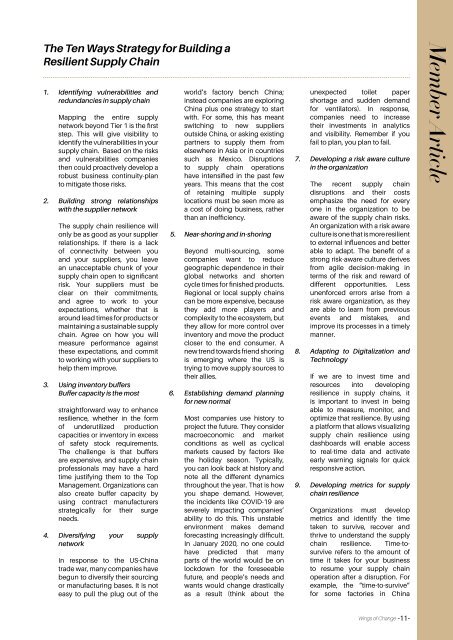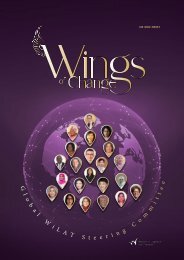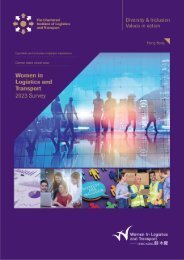Wings of Change Newsletter October 2023
The 9th edition of the newsletter from WiLAT
The 9th edition of the newsletter from WiLAT
Create successful ePaper yourself
Turn your PDF publications into a flip-book with our unique Google optimized e-Paper software.
The Ten Ways Strategy for Building a<br />
Resilient Supply Chain<br />
1. Identifying vulnerabilities and<br />
redundancies in supply chain<br />
Mapping the entire supply<br />
network beyond Tier 1 is the first<br />
step. This will give visibility to<br />
identify the vulnerabilities in your<br />
supply chain. Based on the risks<br />
and vulnerabilities companies<br />
then could proactively develop a<br />
robust business continuity-plan<br />
to mitigate those risks.<br />
2. Building strong relationships<br />
with the supplier network<br />
The supply chain resilience will<br />
only be as good as your supplier<br />
relationships. If there is a lack<br />
<strong>of</strong> connectivity between you<br />
and your suppliers, you leave<br />
an unacceptable chunk <strong>of</strong> your<br />
supply chain open to significant<br />
risk. Your suppliers must be<br />
clear on their commitments,<br />
and agree to work to your<br />
expectations, whether that is<br />
around lead times for products or<br />
maintaining a sustainable supply<br />
chain. Agree on how you will<br />
measure performance against<br />
these expectations, and commit<br />
to working with your suppliers to<br />
help them improve.<br />
3. Using inventory buffers<br />
Buffer capacity is the most<br />
straightforward way to enhance<br />
resilience, whether in the form<br />
<strong>of</strong> underutilized production<br />
capacities or inventory in excess<br />
<strong>of</strong> safety stock requirements.<br />
The challenge is that buffers<br />
are expensive, and supply chain<br />
pr<strong>of</strong>essionals may have a hard<br />
time justifying them to the Top<br />
Management. Organizations can<br />
also create buffer capacity by<br />
using contract manufacturers<br />
strategically for their surge<br />
needs.<br />
4. Diversifying your supply<br />
network<br />
In response to the US-China<br />
trade war, many companies have<br />
begun to diversify their sourcing<br />
or manufacturing bases. It is not<br />
easy to pull the plug out <strong>of</strong> the<br />
world’s factory bench China;<br />
instead companies are exploring<br />
China plus one strategy to start<br />
with. For some, this has meant<br />
switching to new suppliers<br />
outside China, or asking existing<br />
partners to supply them from<br />
elsewhere in Asia or in countries<br />
such as Mexico. Disruptions<br />
to supply chain operations<br />
have intensified in the past few<br />
years. This means that the cost<br />
<strong>of</strong> retaining multiple supply<br />
locations must be seen more as<br />
a cost <strong>of</strong> doing business, rather<br />
than an inefficiency.<br />
5. Near-shoring and in-shoring<br />
Beyond multi-sourcing, some<br />
companies want to reduce<br />
geographic dependence in their<br />
global networks and shorten<br />
cycle times for finished products.<br />
Regional or local supply chains<br />
can be more expensive, because<br />
they add more players and<br />
complexity to the ecosystem, but<br />
they allow for more control over<br />
inventory and move the product<br />
closer to the end consumer. A<br />
new trend towards friend shoring<br />
is emerging where the US is<br />
trying to move supply sources to<br />
their allies.<br />
6. Establishing demand planning<br />
for new normal<br />
Most companies use history to<br />
project the future. They consider<br />
macroeconomic and market<br />
conditions as well as cyclical<br />
markets caused by factors like<br />
the holiday season. Typically,<br />
you can look back at history and<br />
note all the different dynamics<br />
throughout the year. That is how<br />
you shape demand. However,<br />
the incidents like COVID-19 are<br />
severely impacting companies’<br />
ability to do this. This unstable<br />
environment makes demand<br />
forecasting increasingly difficult.<br />
In January 2020, no one could<br />
have predicted that many<br />
parts <strong>of</strong> the world would be on<br />
lockdown for the foreseeable<br />
future, and people’s needs and<br />
wants would change drastically<br />
as a result (think about the<br />
unexpected toilet paper<br />
shortage and sudden demand<br />
for ventilators). In response,<br />
companies need to increase<br />
their investments in analytics<br />
and visibility. Remember if you<br />
fail to plan, you plan to fail.<br />
7. Developing a risk aware culture<br />
in the organization<br />
The recent supply chain<br />
disruptions and their costs<br />
emphasize the need for every<br />
one in the organization to be<br />
aware <strong>of</strong> the supply chain risks.<br />
An organization with a risk aware<br />
culture is one that is more resilient<br />
to external influences and better<br />
able to adapt. The benefit <strong>of</strong> a<br />
strong risk-aware culture derives<br />
from agile decision-making in<br />
terms <strong>of</strong> the risk and reward <strong>of</strong><br />
different opportunities. Less<br />
unenforced errors arise from a<br />
risk aware organization, as they<br />
are able to learn from previous<br />
events and mistakes, and<br />
improve its processes in a timely<br />
manner.<br />
8. Adapting to Digitalization and<br />
Technology<br />
If we are to invest time and<br />
resources into developing<br />
resilience in supply chains, it<br />
is important to invest in being<br />
able to measure, monitor, and<br />
optimize that resilience. By using<br />
a platform that allows visualizing<br />
supply chain resilience using<br />
dashboards will enable access<br />
to real-time data and activate<br />
early warning signals for quick<br />
responsive action.<br />
9. Developing metrics for supply<br />
chain resilience<br />
Organizations must develop<br />
metrics and identify the time<br />
taken to survive, recover and<br />
thrive to understand the supply<br />
chain resilience. Time-tosurvive<br />
refers to the amount <strong>of</strong><br />
time it takes for your business<br />
to resume your supply chain<br />
operation after a disruption. For<br />
example, the “time-to-survive”<br />
for some factories in China<br />
Member Article<br />
<strong>Wings</strong> <strong>of</strong> <strong>Change</strong> -11-
















